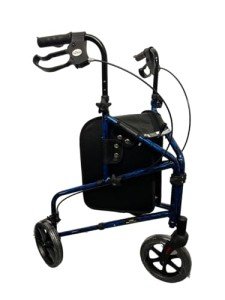Buzzwords, De-Buzzed: 10 Other Ways To Deliver Senior Walker
페이지 정보
작성자 Zelma Toothman 작성일25-06-12 20:11 조회86회 댓글0건본문
A Comprehensive Guide to Senior Walkers: Enhancing Mobility and Independence
As people age, keeping mobility ends up being essential for preserving self-reliance and quality of life. For numerous seniors, walking aids such as walkers offer a valued service to help them browse their environment securely and with confidence. This post looks into the diverse world of senior walkers, including their types, benefits, usage, and some often asked questions.
Understanding Senior Walkers
Walkers, frequently described as walking frames, are mobility aids created to supply support and balance for people who might have difficulty walking independently. They normally consist of a sturdy frame, grips for holding, and often, wheels for ease of movement. Comprehending the different types of walkers readily available can help seniors and their caregivers make well-informed choices.

Types of Senior Walkers
| Walker Type | Description | Best For |
|---|---|---|
| Standard Walker | A four-legged frame that must be lifted to progress. | Seniors requiring maximum stability. |
| Two-Wheeled Walker | A walker with two wheels on the front for easier mobility. | Those with small balance problems. |
| Four-Wheeled Walker | A walker with four wheels, typically includes a seat and brakes. | Active seniors requiring mobility and rest durations. |
| Rollator Walker | A kind of four-wheeled walker that is lightweight and foldable. | Seniors who are more active and require small assistance. |
| Platform Walker | A specialized walker with a platform for support, often used in physical therapy. | People needing particular assistance for injuries. |
Benefits of Using Senior Walkers
Senior walkers supply many benefits that substantially improve the mobility and independence of Elderly Walker people. Here are some of the most significant advantages:
- Increased Stability: Provides a strong base of assistance, reducing the risk of falls.
- Boosted Confidence: Encourages motion and can alleviate anxiety about walking.
- Enhanced Posture: Helps preserve an upright posture while walking.
- Social Engagement: Facilitates involvement in social activities by allowing mobility.
- Therapeutic Use: Can be used during rehabilitation to improve strength and balance.
Picking the Right Walker
When picking a walker, different elements should be considered to make sure the very best fit. Below are crucial points seniors or caretakers must assess:
- Weight Capacity: Ensure the walker can support the user's weight.
- Height Adjustability: A correct height change is vital for convenience and efficiency.
- Mobility Needs: Consider the user's specific requirements, such as level of stability needed.
- Way of life Factors: Think about where the walker will be utilized and how frequently.
Correct Use of Walkers
To make the most of the benefits and reduce risks connected with walkers, correct usage techniques are necessary. Here are steps seniors must follow:
- Stand in the Walker: Position the walker in front of them, guaranteeing it is stable.
- Grip the Handles: Hold the handles securely, guaranteeing a comfy grip.
- Walk Inside the Frame: Move forward by taking little actions, ensuring the front legs of the walker remain on the ground.
- Turn with Care: To alter direction, pivot on the feet while moving the walker.
- Use Cautiously: Avoid rushing and remember to take breaks when tired.
Regularly Asked Questions (FAQs)
What is the average cost of a senior walker?
The price of senior walkers can differ based upon features and products utilized. Standard walkers may cost as low as ₤ 30, while innovative models with wheels and seats might vary from ₤ 50 to ₤ 150.
How do I determine if my loved one needs a walker?
Indications that a senior might require a walker can include regular stumbling or losing balance, a current surgical treatment or injury affecting mobility, and avoiding walking or engaging in social activities.
Can a walker assist with rehabilitation workouts?
Yes, walkers can be a crucial part of physical treatment, assisting seniors restore strength and dexterity through safe movement.
Where can I acquire a senior walker?
Walkers can be purchased at medical supply shops, pharmacies, or online merchants. Some insurance plans may even cover part of the expense.
How do I preserve a senior walker?
Regular upkeep involves examining for loose parts, guaranteeing brakes work correctly, and cleaning the frame to avoid rust or wear.
Senior walkers are an invaluable resource for keeping mobility and independence as one ages. With various kinds of walkers available, it is necessary for seniors and caregivers to consider individual needs, use, and comfort when choosing an appropriate walking aid. By encouraging safe mobility, walkers not just boost physical capabilities however also favorably effect social connections and mental health and wellbeing.
Through proper usage and care, seniors can enjoy an active, engaging lifestyle, bolstered by the support of their walker. Understanding the importance of mobility aids like walkers is fundamental in promoting improved life quality for seniors facing mobility obstacles.
댓글목록
등록된 댓글이 없습니다.




















